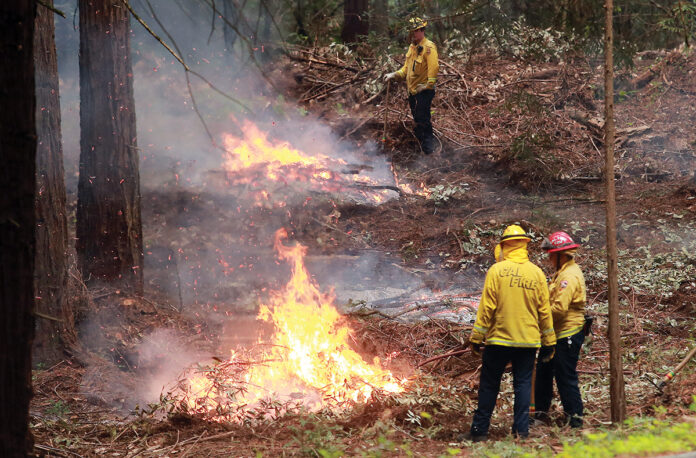The air’s a bit hazy and it smells like someone’s having a campfire.
It’s 11:11am on March 8, and fire appears to snake along the underbrush, lapping at twigs, cascading upwards, alongside ponderosa pine trees.
But there will be no hotdogs and marshmallows today. And this isn’t the latest wildfire to threaten the Santa Cruz Mountains.
It’s the culmination of months of preparation, as California State Parks conducts a controlled burn in Henry Cowell Redwoods State Park along Graham Hill Road.
“We’re leaving the trees in place, but we’re reducing all the fuels underneath,” said Tim Hyland, with a “combi tool” in hand that’s a hoe, shovel and pick all in one.
The idea, he said, is to boost forest health while cutting down on the chance of another wildfire like 2020’s devastating CZU Lightning Complex.
Over the last year, burn piles have been accumulating along Sims Road and Lockewood Lane in the ecologically-sensitive sandhills. The park ended up sporting some 140 drying wood mounds in total.
In the fall, the woodpiles were too green to burn, as that would have led to too much smoke, Hyland said.
“They hadn’t completely cured by that point,” he said. “We weren’t in a crashing rush to burn them.”
This week’s burn was supposed to begin on March 3 and wrap up March 6. But the amount of rain that arrived wasn’t enough to combat the risks presented by furious winds—even with water sources placed at each pile.
Instead, the crew worked on cutting lines around the future mini-blazes, exposing soil with Mcleod and Pulaski hand tools.
“It always is a challenge,” Hyland said on March 4, adding the drought has made things more difficult than in previous wet seasons. “In the last 100 years, you could count on rain in January and February.”
However, Cal Fire chose to continue its controlled burn along Bonny Doon Road on March 4. That “shaded fuel break” project has been going on for the past couple of weeks, said Cal Fire Spokesperson Cecile Juliette, adding that it was cheaper to burn the wood than to run it through a chipper. The specific area was not affected by the 2020 wildfires, Juliette said.
Crews were eliminating ladder fuels that provide a transition plane for flames from smaller trees to the broader canopy, she said, adding the controlled fire was along an important evacuation route.
It was a Cal Fire controlled burn west of the city of Shasta Lake (underway at the same time as the one in Santa Cruz County) that led to the Flanagan Fire, the agency reported, according to the Redding Record Searchlight.
And October’s Estrada Fire near Corralitos was an escaped prescribed burn, part of Cal Fire’s Vegetation Treatment Program.
Cal Fire officials said they were unclear about whether or not it had actually burned in Bonny Doon on the day State Parks canceled its burn, although two Press Banner reporters verified it did proceed.
In an interview, Cal Fire San Mateo Santa Cruz Unit Chief Nate Armstrong said it’s quite advantageous to burn right after light rains if the piles are covered properly during the showers.
“There’s also significant microclimates in the area depending on orientation, elevation, etc., so we may have had an acceptable relative humidity and wind in Bonny Doon where they did not down on Graham Hill,” he said, adding the project was different from the much-larger “broadcast burn” that sparked Estrada. “We only burn a manageable number of piles at a time that the firefighters on scene can effectively monitor and manage. We also extinguish all of our piles at the end of every day and work them very well to make sure that there’s no embers that could be blown into surrounding vegetation in the evening hours.”
According to Armstrong, Cal Fire always has at least one engine assigned to the controlled burn marked as unavailable to respond to other emergencies so piles aren’t left unattended.
By Sunday, the wind had died down enough that State Parks was able to light up about 50 piles in Henry Cowell, although by the next day it was proceeding more cautiously, Hyland explained.
“We’re a little further out from the rain,” Hyland said, reporting he only expected to get through 12 piles Monday.
So workers in yellow outfits—around 15 of them—fanned out through the twisted live oaks like an army unit, passed logs to one another and tossed deadfall onto blazes from a safe distance.
And when the flames soared, suddenly a firehose stream of water arced toward the pile.
Then it was back to the grind of feeding the flames, once again.
Hyland says State Parks jumped aboard the Cal Fire-funded project when it was proposed, due to just how unique the area is.
“This work was happening in the Santa Cruz Sandhills, which is a rare endemic plant and animal community that’s found only in Santa Cruz,” he said, noting the spot is home to the Santa Cruz kangaroo rat, the federally-listed Mount Hermon June beetles and the Zayante band-winged grasshopper. “It has all of the nifty things about the sandhills.”
On Wednesday, Hyland reported they’d made it through about half the burn piles, but would have to wait for more rain to finish off the rest.









![Top 3 Best Websites for Super Clone Watches [2026]: Tried & Tested best super clone watches websites](https://pressbanner.com/wp-content/uploads/sites/30/2025/12/best-super-clone-watches-websites-100x70.jpg)
